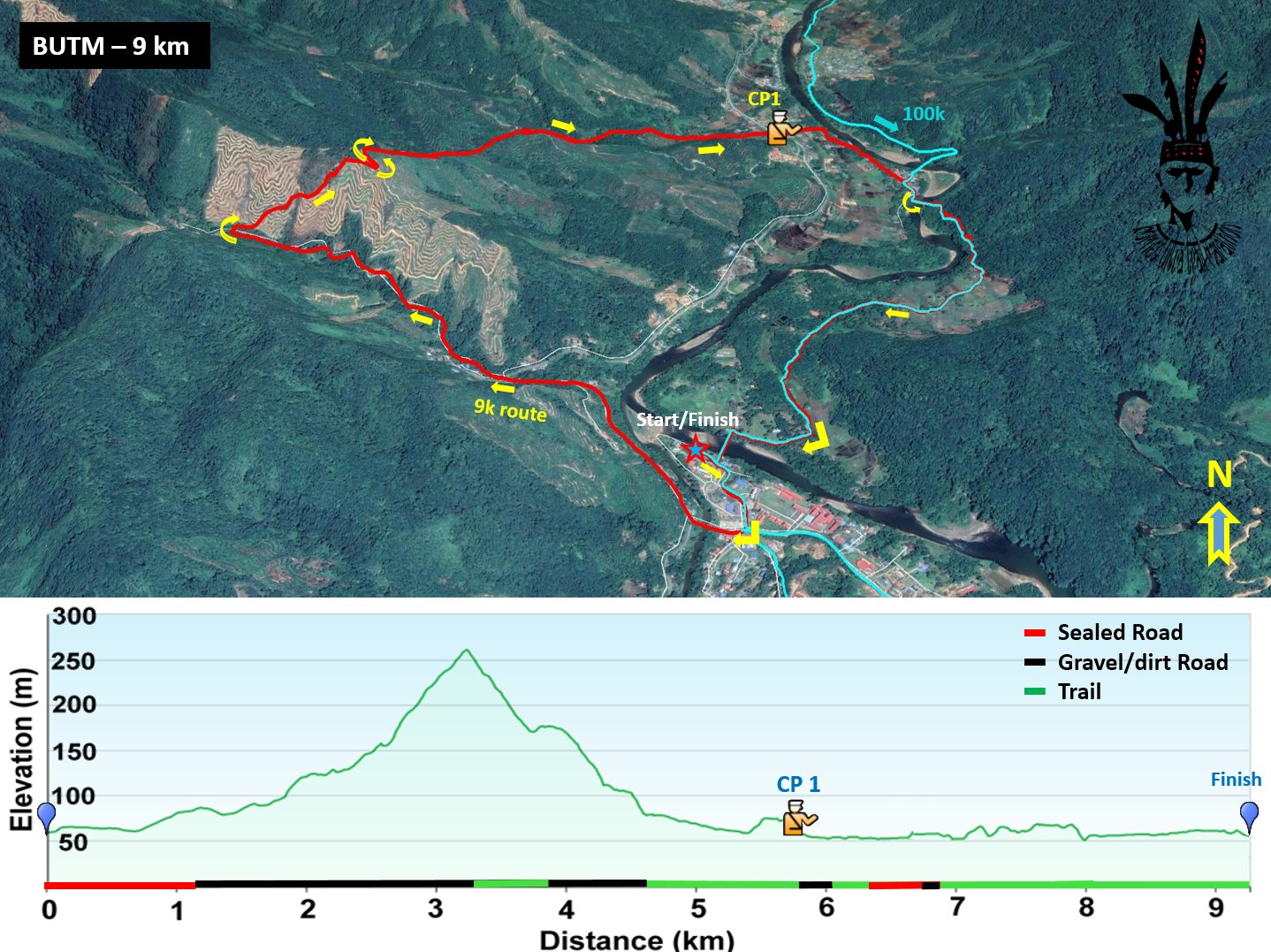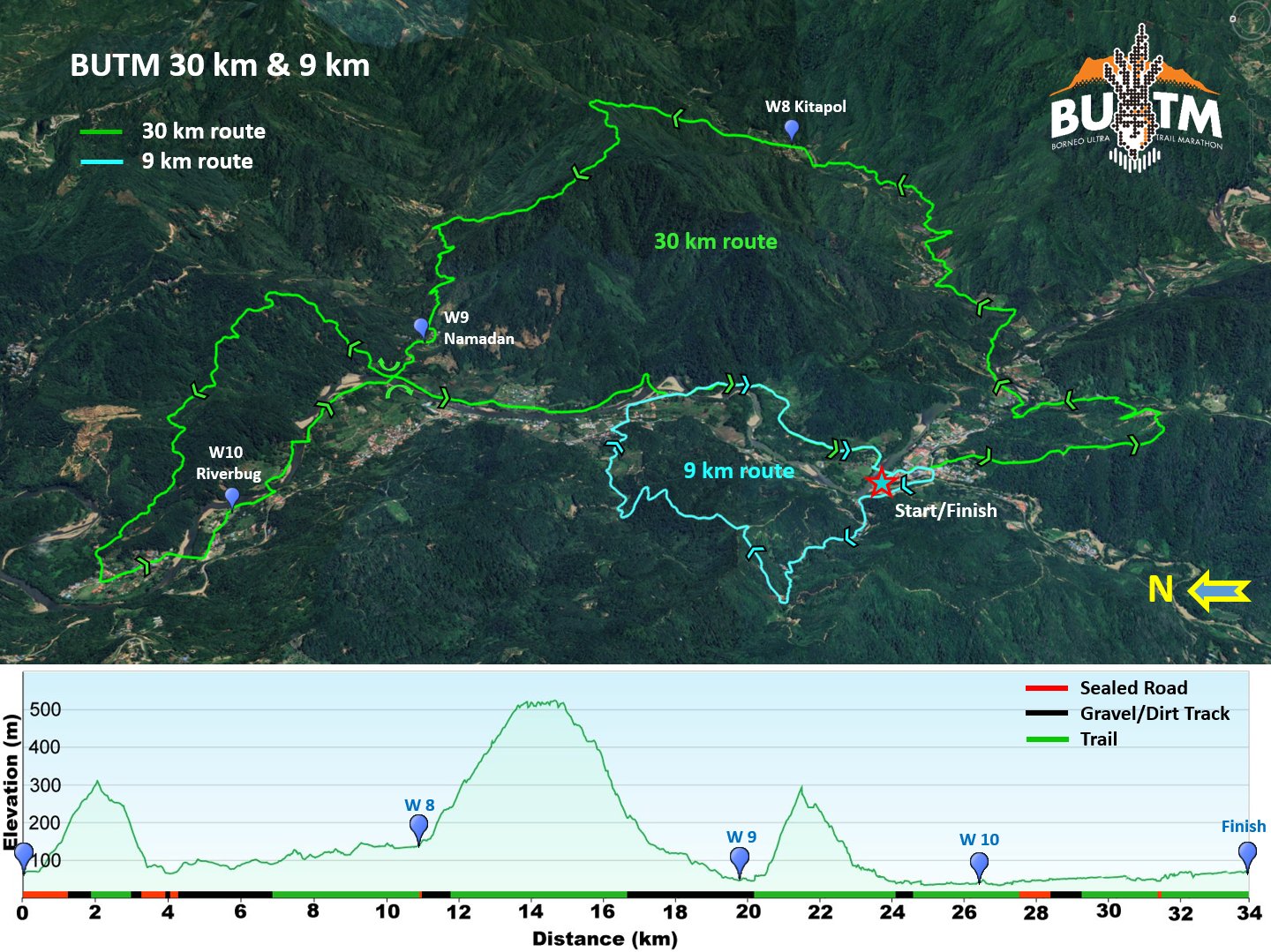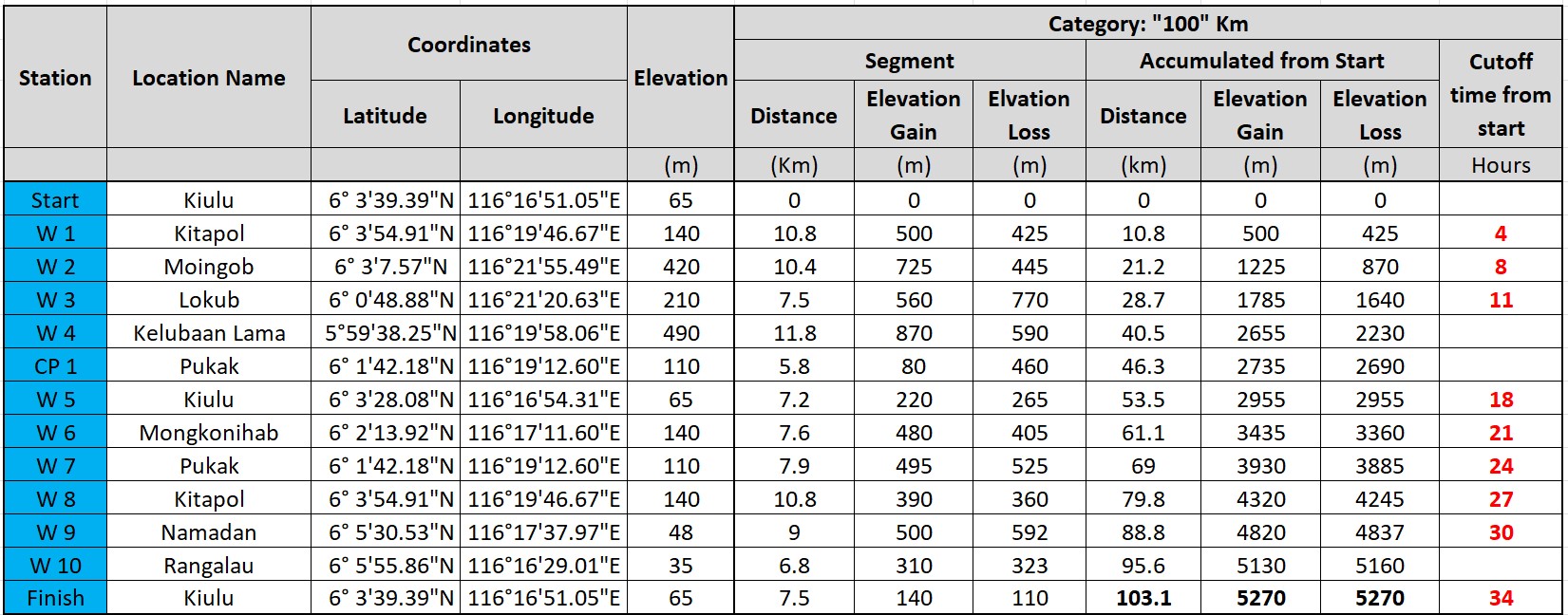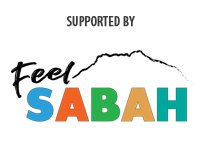The 2025 routes have been updated with some route changes compared to previous versions. We suggest to study the routes carefully to avoid surprises. The central start/finish area at Pekan Kiulu is maintained, and the distance categories have been maintained similar at 103 km, 50 km, 34 km and 9 km.
All courses have start and finish at the Riverside Park at Pekan Kiulu. Outlines of the current routes and elevation profiles are provided below together with course details. Any further updates and more detailed route descriptions will be provided to all competitors prior to the race.
The Water (Aid) stations are numbered W1 to W10 based on the 100 km course. The 30k course will skip W1 to W7 and go to W8 from the start. The 50 km course will skip W1 to W5 and go to W6 from the start (second half of 100 km course) - please refer to the course maps below.
The 2024 routes were ITRA rated with 5 points for the 100k, 3 points for the 50k and 2 points for the 30k routes. The amended courses for 2025 have been sumitted and are expected to maintain the same ratings. The 100 km BUTM 2025 course will also be a qualifying race for the Western States 100-mile Endurance Race in 2026 and be part of the ITRA National League Championship, see also under general information.
You may note that the accumulated elevation gains in the ITRA ratings are lower than in the course details below. This is due to a filtering process performed by ITRA where they filter out smaller undulations in the GPS elevation record which could be caused by inaccuracies in the measurements. We have kept the data from the original GPS tracks in our course data as we know that many parts of the flatter looking sections have these small but steep ups and downs which can absolutely be felt when you are out on the course, but which are filtered out by the ITRA data filtering process. The experience from many wrist GPS watches is that they will show slightly longer distances and sometimes higher elevation gains than our records with the larger hand-held GPS.

NOTE The distances and elevation gains/losses provided are measured with a Garmin GPS64. You may find that you get different data if you are carrying a gps or other device to measure distances and elevations during the race. You will most likely record longer distances. This is due to a combination of inaccuracies in the GPS recording through for instance loss of signal under forest canopies, additional distance travelled around aid stations etc as well as a loss of distance when the course is filtered by being represented by linear segments between GPS points. Wrist-type gps devices may also not achieve as good reception and be as reliable as the larger GPS units.
9 km Route
The "Short Course" is intended as a non-competitive "family-oriented" run with a good opportunity to introduce the next generation to trail running. The current course is 9 km, which by some is considered too long for kids, but we have in past races often seen the parents struggle more than the kids - give them a chance and you may be surprised. The current 9 km route starts at the Kiulu Riverside and runs through town to join the main road for just under 1 km before turning off onto a gravel road. A gradual climb on the gravel road is followed by a steep climb on a dirt track up a hillside to the ridgeline. This is followed by a descent through young rubber plantations to a river crossing to reach a smaller trail that leads to a larger river crossing. Should the rivers be too high to cross safely, competitors will be redirected to an alternative route. After the second river crossing, the route follows small trails alongside padi fields and through a rubber plantation to reach CP1 at the crossing of the main sealed road. After short road and trail sections, the route joins the 100 km route through a mixture of forest, pineapple/rubber plantations and alongside padi fields to the finish line. There will be a water station with refreshments where the 9km trail joins the 100 km trail.

30 km Route
After a short run through town, the 30 km route starts straight into one of three major hills on the 30 km course - see profile below. The first stretch is on concrete road followed by a gravel road that has plenty of space for overtaking to allow participants to sort themselves out in terms of speed. After a 250 m climb, runners will turn left to take a dirt track / trail back down to the river valley to cross the main river on a newly completed road bridge to avoid any queues forming at hanging bridges. Enjoy the views to Mount Kinabalu and surrounding valleys during the initial descent.
After crossing the main river it is 3 km on undulating dirt road, following the river to Mantaranau much of the way. This is a fast section for those who prefer the more open gravel and dirt tracks. From Mantaranau it is a new route for 2025, starting with a kilometer on dirt track then 3 km on small trails through forest, crossing numerous smaller streams to reach W8 at Kitapol. The trail is narrow but generally good with shade and plenty of opportunities to cool off in the small streams. These can generally be crossed without getting wet shoes. W8 is in a new hall along the main river - this also provides a good opportunity for a refreshing dip before the next hill which is the main climb on the 30 km route.
From W8 the course climbs steeply for 400m elevation gain, initially on a dirt track, then going into trails through forest and bamboo to follow an undulating ridgeline before descending on trails through mixed forest and rubber plantations to reach a dirt road. This joins a larger gravel/dirt track at the bottom of the 400 m descent. The undulating gravel/dirt track descends further over 2.5 km to W9 at Namadan.
From W9 the course continues for a short distance on the dirt track, then crosses a suspension bridge for a steep 250m climb through forest to reach a deteriorated road. The road is followed a short distance downhill, then taking a trail past a major landslide and continuing downhill through forest, initially on open trails that gradually turn into a smaller trail that crosses a stream several times. The stream crossings can generally be carried out with care without getting wet shoes. The course then joins a gravel road that passes through Rangalau, crosses a hanging bridge and follows a trail to W10 at The Adventure Centre along the Kiulu River.
From W10 the course follows the main Kiulu river valley upriver on variable road, track and trails to the finish line at Kiulu.


"50" km Route
The 2025 50k route follows the second (yellow) loop of the 100 km route - see further below under 100k description. The "50k" route initially follows the same route as the 30k but continues for another 3 km of gravel road and additional 200 m elevation gain up the ridgeline. This is followed by a 400 m descent on trail and dirt road to reach W6. From W6 it is a 300 m climb over a bit more than 1 km mainly on trail through forest and rubber plantations to reach a ridgeline with a rough track. This track keeps climbing up the ridge for another 1.5 km to gain another 150 m before transitioning to a 5 km long descent to reach W7 at Pukak situated along the main river - an excellent spot for a quick refresher to cool off on a hot day.
From W7 the course follows trails along the river valley before rejoining the 30km trail to W8. The rest of the 50 km course is the same as the 30 km course, initially following the main river on undulating dirt road to Mantaranau. From Mantaranau the new route for 2025 follows a kilometer on dirt track then 3 km on small but good trails through forest, crossing numerous smaller streams (can generally be crossed without getting wet shoes) to reach W8 at a new open hall at Kitapol - another good location for a dip in the river to cool off before the next large hill.
From W8 the course climbs steeply for 400m elevation gain, initially on a washed-out dirt track, then going into trails through forest and bamboo to follow an undulating ridgeline. Where the canopy opens up, there are excellent views towards the river valley and ridges with Mt. Kinabalu further in the background on a clear day. From the ridgeline, it is a 2 km descent on trails through mixed forest and rubber plantations to reach a dirt road that joins a larger gravel/dirt track at the bottom of the 400 m descent. The undulating gravel/dirt track descends further over 2.5 km to W9 at Namadan.
From W9 the course continues for short distance on the dirt track, then crosses a suspension bridge for a steep 250m climb through forest to reach a deteriorated road. The road is followed a short distance downhill, then taking a trail past a major landslide and continuing downhill through forest, initially on open trails that gradually turn to a smaller trail that crosses a stream several times. These can generally be crossed without getting wet shoes during dry conditions. The course then joins a gravel road that passes through Rangalau, crosses a hanging bridge and follows a trail to W10 at The Adventure Centre along the Kiulu River.
From W10 the course follows the main Kiulu river valley upriver on variable road, track and trails to the finish line at Kiulu.


100 km Route
The "100k" route resembles a figure 8 with the start/finish and halfway station (W5) centered in the middle, see figure below. The blue loop with the largest hills and the most technical section on the course will be completed first to ensure daylight on the technical sections. Competitors then return to the start/finish area, which also works as half-way station with access to the competitor's half-way drop-bag and provision of the main halfway meal. This will be followed by the yellow loop. The first loop has the largest hills and is considered the harder part of the course on the section between W2 and CP1.
The first loop of the "100k" course follows the same course as the 30 km to W1/W8 at Kitapol - please refer above. After W1, the 100 k climbs 400m over 4 km on gravel, then drops 300m over a 1 km mostly sealed road to reach a major river crossing. This may be crossed via a hanging bridge or via a ford that gives a good opportunity for a refreshing dip in the river. From the river crossing, it is an initial steep uphill, then 3 km on a gradually climbing gravel/dirt track to reach W2 at Moingob.
From W2, it is 2.5 km with 400 m elevation gain on a small trail through forest, crossing to larger and a couple of smaller streams to reach the top of the ridge at the "shoulder" of Bukit Tikolod. From here there are excellent views on a clear day to W1 at Kitapol with the ocean further in the background and looking forward to the river valley with W3 and the large horseshoe shaped ridgeline leading to W4 - take a moment to enjoy! From the top it is 4 km, 600m descent on mixed trail and dirt road, passing through the picturesque Kg. Sinansag with refreshments to reach W3 at Lokub.
From W3 it is the largest hill on the course with 12 km, close to 900m ascent and 600m descent to reach W4 at Kelubaan Lama. It starts with 700m of sealed road followed by gravel road that deteriorates into a track and eventually a trail section to reach W4. Views from along the ridgeline are spectacular on a clear day. From W4, it is a quick downhill on a mix of dirt and sealed road to reach the river at the bottom, then a short trail section to reach CP1/W7 at Pukak. From W7 the course follows the river valley downstream on a mix of trails, dirt tracks and a bit of sealed road to reach the halfway station of W5 back at the hall at Kiulu.
From W5, the 100 km route is the same as the 50 km route - please refer to description above.





















